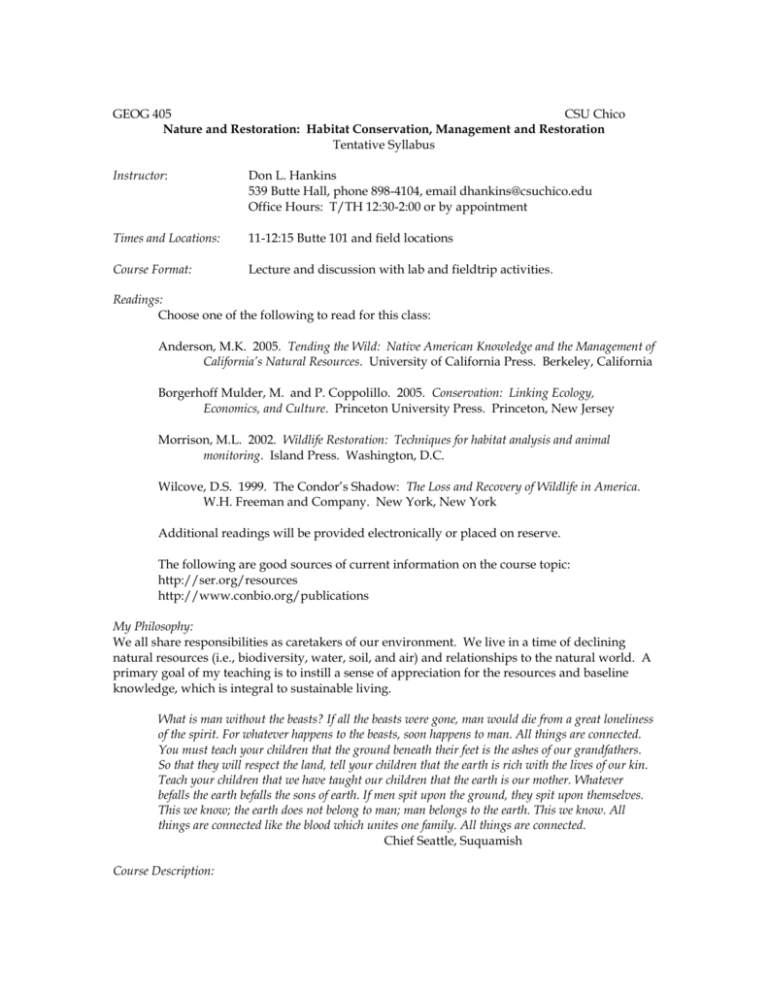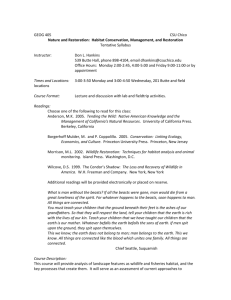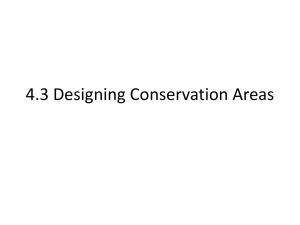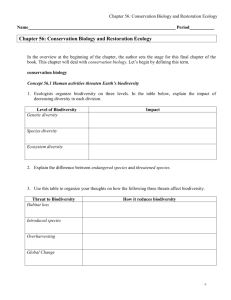Habitat Conservation, Management, and Restoration
advertisement

GEOG 405 CSU Chico Nature and Restoration: Habitat Conservation, Management and Restoration Tentative Syllabus Instructor: Don L. Hankins 539 Butte Hall, phone 898-4104, email dhankins@csuchico.edu Office Hours: T/TH 12:30-2:00 or by appointment Times and Locations: 11-12:15 Butte 101 and field locations Course Format: Lecture and discussion with lab and fieldtrip activities. Readings: Choose one of the following to read for this class: Anderson, M.K. 2005. Tending the Wild: Native American Knowledge and the Management of California’s Natural Resources. University of California Press. Berkeley, California Borgerhoff Mulder, M. and P. Coppolillo. 2005. Conservation: Linking Ecology, Economics, and Culture. Princeton University Press. Princeton, New Jersey Morrison, M.L. 2002. Wildlife Restoration: Techniques for habitat analysis and animal monitoring. Island Press. Washington, D.C. Wilcove, D.S. 1999. The Condor’s Shadow: The Loss and Recovery of Wildlife in America. W.H. Freeman and Company. New York, New York Additional readings will be provided electronically or placed on reserve. The following are good sources of current information on the course topic: http://ser.org/resources http://www.conbio.org/publications My Philosophy: We all share responsibilities as caretakers of our environment. We live in a time of declining natural resources (i.e., biodiversity, water, soil, and air) and relationships to the natural world. A primary goal of my teaching is to instill a sense of appreciation for the resources and baseline knowledge, which is integral to sustainable living. What is man without the beasts? If all the beasts were gone, man would die from a great loneliness of the spirit. For whatever happens to the beasts, soon happens to man. All things are connected. You must teach your children that the ground beneath their feet is the ashes of our grandfathers. So that they will respect the land, tell your children that the earth is rich with the lives of our kin. Teach your children that we have taught our children that the earth is our mother. Whatever befalls the earth befalls the sons of earth. If men spit upon the ground, they spit upon themselves. This we know; the earth does not belong to man; man belongs to the earth. This we know. All things are connected like the blood which unites one family. All things are connected. Chief Seattle, Suquamish Course Description: This course will provide analysis of landscape features as plant, wildlife, and fisheries habitat and the key processes that create them. It will serve as an assessment of current approaches to conservation of habitats and the methods and approaches to restore degraded habitats. All organisms (plants, invertebrates, vertebrates, etc.) will be discussed from the population to landscape scale. This course will include discussion of the historic drivers for habitat loss and the tools used to offset those losses (e.g., mitigation banking and conservation planning). Key environmental policies related to conservation, management, and restoration will be analyzed. Course Objectives: Students will be versed in examples of local to international approaches to the conservation, management, and restoration of habitat. Students will gain an appreciation for the variations in methodological approaches, data, politics, and constraints to conservation, management, and restoration. Students will able to develop an outline and framework approaches to conserving, managing, and restoring habitats of interest. Assignments: Midterm Final Exam Lab/Field Activities (including fieldtrips) Service Learning (18 hours) Journal/Reflections Research Paper Outline Research Paper Oral Presentation Grading: Grades will be assigned on a straight scale based on the points earned for each assignment (See example grade ranges below). This system will enable each student to earn a fair grade based upon the percent of points earned on assignments rather than competing with others in the class for the top grade. Make-up exam(s) will be given for excused absences only, and must be completed within a week of returning to class. One late homework assignment will be accepted without an excused absence. Other late assignments will have 10 % deducted for each day they are late. No assignments will be accepted more than one week after the due date. All written assignments based on assigned readings will be due one week from the date assigned unless otherwise advised. Incompletes will only be considered if most of the course requirements have been fulfilled. Spelling, grammar, and composition will be considered part of the grading of the assignment. A 93.5% A- 90% B+ 87% Etc. Midterm Final exam Service Learning Journal/Reflections 50 75 50 40 points points points points (11 %) (16 %) (11%) (9 %) Essay Outline Research Essay OR Species/Management Compendium Oral Presentations Lab/Field Assignments 20 75 points points (4 %) (16 %) 75 50 100 points points points (11 %) (22%) Total 440/460 points (100 %) (Note: these values are an approximation of point allocation. Additional points for other assignments may be assigned at instructor’s discretion) Tentative Schedule: Week Topic 1 Introduction and Overview Importance of habitat conservation, management, and restoration 2 Activity Regional biodiversity and conservation, management, and restoration assessment Conservation biogeography/Landscape ecology Physical Processes as drivers of habitat structure and diversity (fieldtrip) 3 Mechanisms of biodiversity loss and habitat degradation 4 TENTATIVE AFTERNOON FIELDTRIP Environmental policy and regulation 5 Conservation and recovery of species and their habitats: principles of reserve design 6 7 8 Habitat analysis: terrestrial Principles of Reserve Design Habitat analysis: freshwater Habitat analysis: marine Approaches to habitat restoration Conservation Case Study: Threats Matrix Fieldtrip Habitat Lab 9 10 11 12 13 14 15 MIDTERM Goals and Objectives of Restoration Projects Conservation Planning Captive breeding and Reintroductions Genetic and demographic conservation and restoration: the role of metapopulations Monitoring The community approach to conservation, management, and restoration Holiday Week Conservation Financing Cultural restoration/conservation Conservation Planning/NCCP Wildlife/fisheries restoration (fieldtrip) Mitigation and management in perpetuity 16 Synthesis, presentations, and review 17 Final Exam







